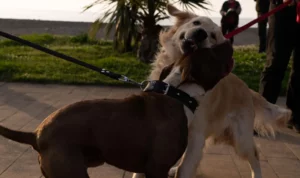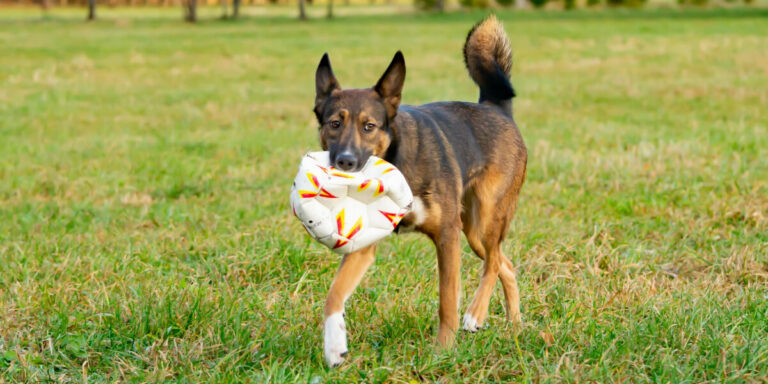It is natural for a dog to be excited being around other dogs, especially if it is their own kind. Dogs are naturally pack animals which means they are used to be in groups. They are highly social animals and they constantly long for attention and the presence of others.
But what do you think will happen if your canine buddy gets too much excited being around others and he gets completely out of hand? It may be possible that your dog’s barking, whining, and jumping may not be pleasing for other dogs. Your dog can put himself in danger of being attacked or bitten if other dogs do not like being invaded of their personal space.
One issue that is concerned when your canine buddy is excited is that his excitement may develop into an aggressive behavior. Hyperactive dogs can be related to a dog that is developing fears and anxieties. If you restrain your dog from reaching from other dogs, it may just create further tension that may result to negative energy.
Also, if you punish your dog for his behavior it may just lead to a negative association when being around other dogs.
When your canine buddy crosses paths with other dogs, of course you want him to not only be friendly but also calm and confident. It is important for your dog to know how to be calm around other fur babies so he wouldn’t invade their space and not cause any threat.
You may also need to find other dogs to help calm down your dog, find a dog that is mature and calm to help your dog during training. Provide treats to make positive reinforcements to your dog when he behaves calmly and positively. Avoid letting your dog have access to other dogs when he is not training so that he won’t get too excited
Meet with a friend
Talk to a friend of yours that has a calm canine buddy. Organize to meet your friend with her calm dog while you are out for a walk. Put a leash on your dog and go for a walk to your arranged meeting place.
Stop while calm
Once you see your friend and her god from a good distance, ask them to stop as long as your dog is still calm. Then, ask your dog to sit and stay.
Retreat when needed
Ask your friend and her dog to approach you. Once your dog gets up and starts to be excited, ask your friend to stop and walk away.
Continue with the plan
Wait until your dog becomes calm. Once he is calm and sitting, ask your friend to come close again. As long as your dog remains calm and is sitting, they can come closer. It your dog gets excited again, repeat the previous step.
Repeat, repeat, repeat
Repeat several times until your dog gets the hang of it and he can incorporate that as long as he is sitting calmly, the other dog will come over, and if he is not, the other dog will leave.
2. The Sit and Stay Method
Sit and Stay or Down and Stay
Teach your dog to sit and stay or teach him how to lay down and stay. Practice these while he is on or even without his leash.
Trigger your dog
Ask your friend to take her calm dog over to your house, your yard, or to meet you on a walk. Put your own dog in a leash before your friends calm dog enter your house or your yard.
Command your dog
Once your friend’s calm dog enters, command your dog to lay down and stay. You may use his leash to pull him to one side, but not backwards, if it is necessary to direct him.
Reward your dog’s calmness
When your dog obeys your sit and stay or your lay down and stay command and he is calm even with the presence of another dog, give him a treat. Repeat this in multiple sessions with the help of other dogs for several weeks.
This way your dog will learn that he needs to calmly sit and stay or lay down and stay once a dog enters his home or even when he encounters another dog while he is on the streets.
Reward your dog’s calmness with your goal
Once your dog is calm and all set, let your meet with another dog.
3. The “Get It” method
Provide treats for the command
Place your dog’s treats on the ground right in front of his nose and say the words “get it”.
Move the reward tReat
Begin dropping treats beside you, then behind you, while commanding your dog to “get it”, this way your dog will learn to look for his treat and get it on his own. You put him in a leash, but make sure to make it loose and do not direct him unto where his treats are.
Repeat this step a multiple number of times until it becomes your dog’s instinct to look for treats behind you when you say “get it”.
Expand your game
Try doing the “get it” game with your dog in more distracting environment like the park or anywhere outside your home.
Introduce another dog
Have your friend with the calm dog approach you. One the calm dog is in a good distance, give treats to your dog and command him to “get it”. This way it will distract him from the presence of the other dog and it will teach him to not get excited.
Increase stimulus
After some time move your “get it” game closer to the other dog while still providing treats to your dog. He should remain focused on the treats and no to the calm dog. Repeat this step until your dog starts looking for treats whenever he sees another dog around.







